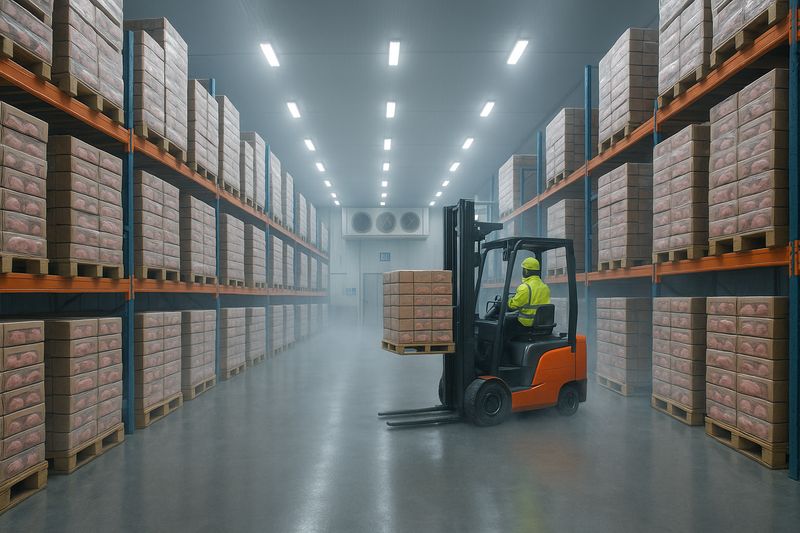
Published in Industry Insights
Europe’s Meat Surplus Problem — and How Inventory Can Be Both Risk and Opportunity
Trade shocks, disease, and rising costs are testing Europe’s meat supply chain — but smart inventory management could turn surplus from burden to advantage.

In Europe’s meat sector, holding stock has always carried tension. The right inventory keeps orders flowing; the wrong surplus drains capital and racks up cold-storage costs. Today, that balance is harder than ever to strike.
What’s driving the surplus?
1. Shifting trade winds
China’s recent anti-dumping tariffs on EU pork and by-products — reaching as high as 62% — have choked a vital export route. Offal and speciality cuts once bound for Asia are now backing up in European cold stores, intensifying domestic competition, and pressuring prices.
2. Disease and biosecurity shocks
Ongoing outbreaks of African swine fever and avian flu keep reshaping supply chains. Regional bans or tightened border checks can turn sellable stock into stranded inventory overnight — especially for exporters in Central and Eastern Europe.
3. High energy and logistics costs
Europe’s cold-chain system is expensive. Elevated energy prices and complex cross-border logistics mean every additional day in storage is costly. For smaller processors, that’s enough to turn a slow-moving product into a loss.
Other factors, forecast errors, consumer diet shifts, and regulatory hurdles, add further strain.
Why it matters
Surplus meat is more than idle stock. It ties up working capital, erodes margins, and raises spoilage risk even under perfect cold-chain conditions. With margins already compressed by energy and labour costs, the impact multiplies quickly. Left unmanaged, surplus undermines pricing stability, brand relationships, and cash flow.
Turning risk into opportunity
Yet inventory, even surplus, doesn’t have to be purely negative. Managed strategically, it can become a source of flexibility and value:
1. Market agility
Inventory provides optionality. Processors with available stock can pivot quickly between export, retail, or processing channels as demand changes.
2. Value-added transformation
Surplus cuts or trimmings can be reworked into processed, marinated, or ready-to-cook products, extending shelf life and creating premium formats rather than write-offs.
3. Smarter planning and analytics
By analysing where surplus originates, be it forecasting gaps, yield variance, or transport delays, processors can fine-tune production and logistics, turning lessons into lasting efficiency gains.
Other opportunities include secondary market partnerships and sustainable re-use, from pet food to bioenergy, aligning with Europe’s circular-economy ambitions.
How Meat Borsa helps
Meat Borsa connects verified European buyers and suppliers through a transparent, data-driven marketplace that makes it easier to list, discover, and move inventory before it becomes surplus.
By providing real-time visibility, verified counterparties, and integrated logistics support, the platform helps suppliers reach new buyers quickly and safely — from processors seeking specific cuts to traders looking for export lots. The result is faster turnover, reduced storage time, and a healthier balance between stock on hand and stock sold.
The bottom line
Across Europe, surplus inventory is fast becoming a structural risk — driven by trade friction, disease outbreaks, and high energy costs. But with better visibility, flexible sales channels, and smarter processing, inventory can shift from liability to advantage. In a market where volatility is the new normal, agility, not avoidance, will define who thrives.
Sources
China slaps up to 62% tariffs on EU pork: https://www.spglobal.com/commodity-insights/en/news-research/latest-news/agriculture/090525-china-slaps-up-to-624-tariffs-on-eu-pork-in-retaliation-over-ev-tariffs
UECBV: Chinese tariffs threaten stability of the European pork sector: https://www.euromeatnews.com/Article-UECBV%3A-Chinese-tariffs-threaten-stability-of-the-European-pork-sector/8853
Logistical challenges facing the meat industry: https://www.foodbusinessreview.com/cxoinsight/logistical-challenges-facing-the-meat-industry-with-fluctuating-demand-nwid-976.html
EU Agricultural Outlook 2024–2035: https://ew-nutrition.com/eu-agricultural-outlook-2024-2035-projected-trends-and-challenges/
Chicken supply chain still struggling with inventory logistics: https://www.wattagnet.com/blogs/poultry-tech-trends/blog/15682700/chicken-supply-chain-still-struggling-with-inventory-logistics
